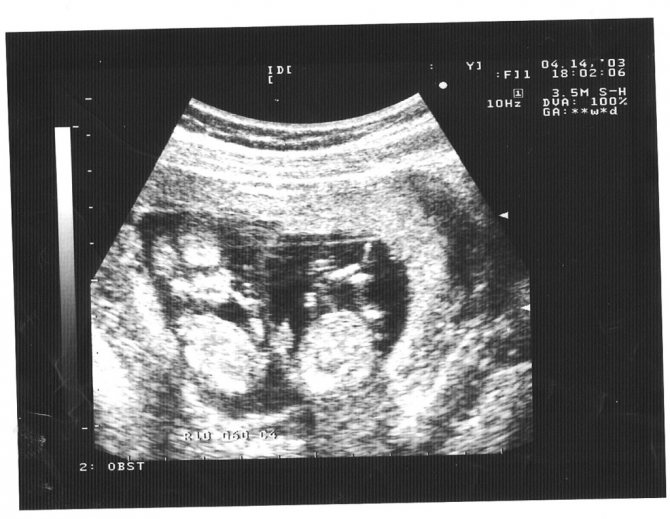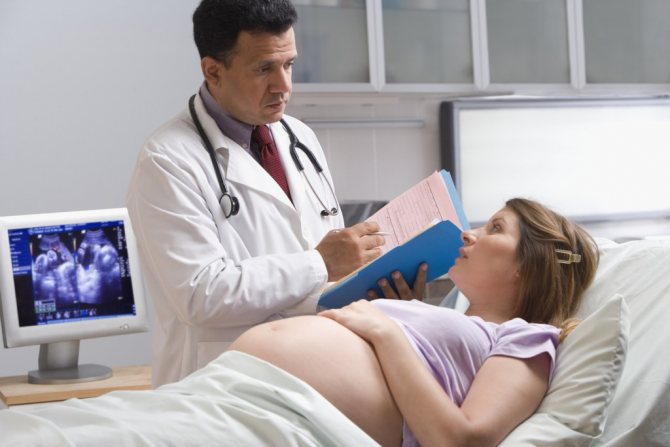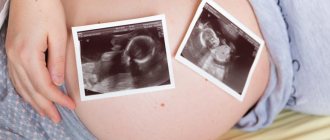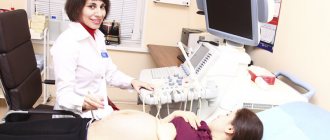Multiple pregnancies are a common occurrence in recent years. Many women dream of giving birth to two or even three babies at once; others, having learned that they are carrying twins, worry whether they will be able to cope with the double load. How does multiple pregnancy work? By what symptoms is it determined? When will an ultrasound show multiple births? What complications occur during multiple pregnancy?
What is multiple pregnancy, how do twins differ from twins?
A multiple pregnancy is a pregnancy in which a woman carries two or more fetuses. If there are 2 of them, this is a pregnancy with twins, if 3 - with triplets. Each of the babies being carried is called a twin. There is an opinion that twins are children who have the same appearance, but if babies born from the same pregnancy do not look alike, they are twins or triplets. In fact, all children born to the same mother from the same pregnancy are called twins.

Multiple pregnancy develops if:
- fertilization of two or more mature eggs at the same time;
- atypical fragmentation of a fertilized egg.
In the first case, the twins are fraternal, or heterozygous. They can be of different sexes and look like any brothers and sisters. They may have the same blood type or different ones.
In the second case, identical or homozygous twins are born. They come in only one gender - both boys or only girls, have almost the same appearance, the same blood type and Rh factor.
Symptoms of multiple pregnancy in the early stages
Multiple pregnancy can be determined in the early stages by the discrepancy between the size of the uterus and the gestational age. The gynecologist draws attention to this when examining the patient in the gynecological chair.
The woman herself may notice increased fatigue, increased urination, and constipation. Since she is carrying not one embryo, but two or more, a positive pregnancy test result can be obtained before her period is missed. However, in most cases, a pregnant woman does not suspect that several babies are developing inside her until the first ultrasound.
Decoding the results
When analyzing the results of ultrasound screening of twins, it is necessary to take into account that the size and weight of embryos may differ from the established norms for a singleton conception. At eleven weeks, the size of the embryos ranges from 4.3-4.8 cm. After a week, their height will be 6 cm and their weight will be approximately 15 g.
In the middle of gestation (approximately the 20th week), the weight of children reaches an average of 350 g, one may be larger than the other. This is explained by the fact that a larger child undergoes regular blood discharge through a blood shunt. These are no longer two dark spots, but well-defined twins on ultrasound with limbs and internal organs. By the last ultrasound in the third trimester, children can gain up to 2 kg.

Diagnostic methods for establishing multiple pregnancy
The most accurate method for diagnosing multiple pregnancy is ultrasound. The first planned examination is carried out at 11–14 weeks, since by this time the fetuses are well visualized. However, an experienced gynecologist is able to determine the presence of several embryos in the uterus at an earlier date. To do this, the doctor uses:
- collection and analysis of anamnesis: multiple pregnancy is possible in the presence of twins and triplets in close relatives on the female side, the abolition of oral contraceptives shortly before conception, treatment for infertility with gonadotropins and Clomiphene, the woman’s mature age and several births in the past;
- examination of a pregnant woman: a multiple pregnancy is indicated by a larger size of the uterus than it should be according to the stage of pregnancy;
- test results: the blood levels of hCG and placental lactogen in multiple pregnancies are 2 times higher than in singleton pregnancies.

Sometimes the first ultrasound does not detect a multiple pregnancy due to outdated equipment, insufficient qualifications of the sonologist and the location of the babies - one can cover the other, located at the back wall of the uterus. In this case, the gynecologist determines multiple pregnancy according to the following criteria:
- upon palpation, 3 large parts of the fetus or more are felt;
- Auscultation reveals several points where the heartbeat is clearly audible, the difference between the heart rate at these points is 10–15 beats;
- when measured with a pelvis, a disproportionately large length of the fetus with a small head is detected;
- The height of the uterine fundus does not correspond to the gestational age.
What causes twin pregnancy?
The process and reasons for the development of two or more fruits have not been fully studied. But there are factors that increase the likelihood of having twins.
Natural factors:
- Heredity. If there have been cases of twin births in the family, then the probability increases.
- Mature age. Women over 35 have a higher chance of having twins.
- Race. African Americans are more likely to give birth to twins, with the smallest percentage being among Asians.
- Pregnancy in the past. The more children a woman already has (especially if she has twins), the higher the likelihood of having twins.
Third party reasons:
The twin pregnancy rate has increased greatly in recent years due to reproductive technologies:
- Drugs that stimulate ovulation. Follicle-stimulating hormone and clomiphene citrate promote the release of up to several eggs in one cycle. When fertilized at the same time, this results in multiple children.
- Assisted reproductive technologies (IVF). In vitro fertilization and other methods use ovulation-stimulating drugs to obtain multiple eggs. They are artificially inseminated in the laboratory and returned to the uterus for implantation and embryo development.
- The use of hormonal contraceptives also has an effect. In the first cycles after their cancellation, the hormonal background has not yet stabilized, and 2 egg cells can be released from each ovary.
At what stage is twins or twins visible on ultrasound, how is the study carried out?
When an ultrasound examination is performed using high-quality modern equipment by a highly qualified specialist, a multiple pregnancy can be diagnosed as early as the 5th week. The monitor will show 2 or more echo-negative formations if fraternal twins develop.
During pregnancy with identical twins, diagnosis is difficult. Such a pregnancy can be detected at approximately 7–8 weeks, when the embryos are clearly visualized. However, even in this case an error is possible.
Ultrasound in the early stages is performed transvaginally. The woman lies on the couch on her back, bends her knees and spreads her legs apart, the diagnostician puts a condom on the vaginal sensor and inserts it deep into the vagina.
During the study, the sonologist determines the size of the uterus, fertilized egg and embryo, the number of embryos (or fetuses, if the study is carried out after the 8th week of pregnancy), their location in the uterus and the location of the chorion or placenta (after the 12th week). The development of children is also assessed, the presence or absence of pathologies or markers of chromosomal abnormalities.

Ultrasound photo of twins at 20 weeks of pregnancy
How to determine
The most informative and reliable diagnostic method, allowing to identify the presence of several fetuses, is ultrasound.
With the help of an echographic examination, it is possible to establish multiple pregnancy with one hundred percent accuracy even in the early stages, up to one and a half months, thanks to which a woman can find out her diagnosis almost immediately. Ultrasound diagnostics is also necessary to determine pregnancy management tactics and prevent possible complications. Therefore, during the procedure, the doctor evaluates the chorionicity and amnioticity of the fetus by the number of placentas and membranes. Pregnancy proceeds most calmly when each baby has its own placenta and fertilized egg. If two fetuses share one placenta in one amniotic sac, the likelihood of complications is maximum.
In addition, the ultrasound method makes it possible to detect developmental defects already in the early stages. This is the only way to rule out a developmental delay or defect, since other tests in this case are not informative.
Important diagnostic criteria are tests for human chorionic gonadotropin (CG) and alpha-fetoprotein (ACE). HCG is synthesized in the fetal membrane, and ACE is produced in its digestive tract. With multiple pregnancies, these figures are increased at least four times. This test is quite informative, but not entirely accurate. With its help, you can establish that there is more than one fetus, but it is impossible to determine how many there are in total.
Additionally, other examination methods may be prescribed:
- laboratory blood and urine tests;
- fetometry – measurement of the main parts of the fetal body using ultrasound. Can be performed separately or during a routine ultrasound;
- cervicometry - transvaginal ultrasound to eliminate the risk of spontaneous abortion or premature birth;
- phonocardiography is an assessment of the child’s heart function, helping to identify myocardial defects, hypoxia, umbilical cord entanglement, etc.
Possible complications that can be detected by ultrasound
Multiple pregnancies often occur with complications, although not all of them pose a serious danger to the babies and mother. Most often, ultrasound reveals the following pathologies:
- polyhydramnios;
- low body weight of children;
- developmental delay of all, several or one child;
- death of one of the fruits.

Also during the study, the position of the fruits is determined. This is especially important before childbirth, as it can affect the choice of method of delivery. Possible locations of twins in the uterus:
- longitudinal (88% of cases) in the right and left parts of the uterine cavity with cephalic presentation of both fetuses (45%), cephalic and pelvic (43%), pelvic (6%);
- longitudinal and transverse position (5.5%);
- transverse position of both fruits (0.5%).
Depending on the identified complications, a decision is made on further management of the pregnancy, method and time of delivery. Childbirth with multiple births usually begins earlier than expected and is complicated by weakening of labor and incorrect position of the children. This is the basis for hospitalization of a woman pregnant with two or more babies, 2-3 weeks before the expected date of birth.
Features of the course, possible complications
Multiple pregnancy is considered more difficult for the expectant mother and is considered high risk. There is an opinion among doctors that this is almost a pathological condition. In such cases, the load on the body is much greater than when only one life is growing in the tummy. Almost immediately, shortness of breath, heartburn and constipation begin to torment, and the urge to urinate becomes more frequent. More than 4 times more often (in comparison with one embryo) the diagnosis of “gestosis”, the so-called late toxicosis, is made. It can only be dealt with while in a medical facility, so there is a high rate of multiple mothers ending up in hospital for conservation.
All this affects the fact that the body’s resources are quickly depleted, and therefore there are more threats of various complications and the likelihood of their occurrence is higher.
Among the dangers for the mother are the occurrence of anemia, abnormal breech presentation of the fetus(es), premature onset of labor, polyhydramnios, placental abruption and/or placental presentation. There is always a risk of miscarriage and the need for premature termination, in other words, abortion.
Toddlers have a high degree of developmental anomalies and are more likely to be born premature and/or with low birth weight. They also talk about the possibility of intrauterine death of one of the two, which can lead to big problems for the health of the second. For example, to cerebral ischemia, which will lead to serious neurological disorders in the future.
The 30th week of pregnancy with twins is considered the reference period. From now on, it is mandatory to undergo weekly examinations with cardiotocography and Doppler ultrasound. These procedures help monitor the condition of the offspring. If the slightest deviations from the normal development of the fetus are detected, the mother is immediately hospitalized.
Right now it is recommended to go on maternity leave and begin active preparation for childbirth. Be prepared for the fact that if you are planning a replenishment of 4 babies, then at 30-32 weeks they will be born.











